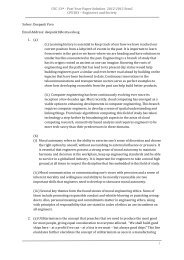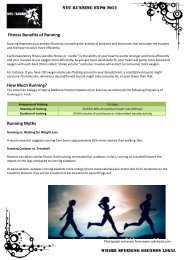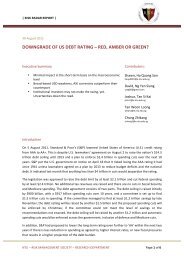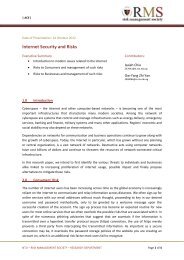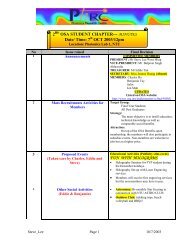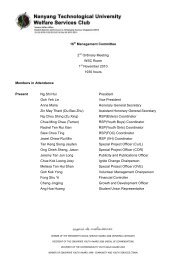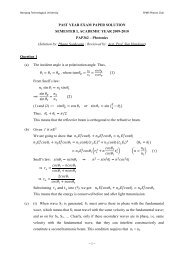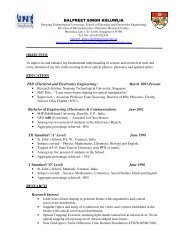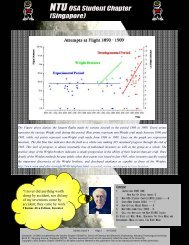AIG, Credit Default Swaps and the Financial Crisis
AIG, Credit Default Swaps and the Financial Crisis
AIG, Credit Default Swaps and the Financial Crisis
You also want an ePaper? Increase the reach of your titles
YUMPU automatically turns print PDFs into web optimized ePapers that Google loves.
| RISK RADAR REPORT |<br />
18 th May 2013<br />
<strong>AIG</strong>, <strong>Credit</strong> <strong>Default</strong> <strong>Swaps</strong> <strong>and</strong> <strong>the</strong> <strong>Financial</strong> <strong>Crisis</strong><br />
Executive Summary<br />
Introduction <strong>and</strong> background to <strong>Credit</strong> <strong>Default</strong> <strong>Swaps</strong><br />
Impacts of crisis on <strong>AIG</strong><br />
Underlying causes of <strong>the</strong> problems experienced by <strong>AIG</strong><br />
Suggested Risk Management Solutions<br />
Conclusion<br />
1.0 Introduction<br />
Contributor:<br />
Zhou Xinzi<br />
zhou0184@e.ntu.edu.sg<br />
During 2006-2007, <strong>the</strong> spectacular burst of <strong>the</strong> US housing bubble ended a bullish run by global<br />
financial markets <strong>and</strong> triggered <strong>the</strong> global financial crisis that marked a depressing end to <strong>the</strong> first<br />
decade of <strong>the</strong> 2000s.<br />
Amongst many financial institutions that received unfavourable spotlight during <strong>the</strong> crisis, <strong>the</strong><br />
collapse <strong>and</strong> consequent bailout of <strong>AIG</strong> was an exceptionally notorious episode because of its former<br />
status as a Wall Street Darling.<br />
In this Risk Radar Report, we look at how <strong>AIG</strong>, ironically an issuer of risk management solutions,<br />
failed to exercise prudent risk management for its own balance sheets <strong>and</strong> discuss, with benefit of<br />
hindsight, measures that should be put in place to prevent future episodes from recurring.<br />
1.1 Background to <strong>Credit</strong> <strong>Default</strong> <strong>Swaps</strong> (CDS)<br />
Unlike traditional insurers, <strong>AIG</strong> was heavily involved in writing CDS. In <strong>the</strong> simplest terms, a CDS is a<br />
bilateral contract involving a protection buyer as well as a protection seller (<strong>AIG</strong> in this case). The<br />
buyer seeks “protection” from <strong>the</strong> seller against <strong>the</strong> default of an underlying reference entity (for<br />
example a corporate bond), <strong>and</strong> in return for <strong>the</strong> protection services, <strong>the</strong> buyer pays a periodic sum<br />
of premium to <strong>the</strong> protection seller.<br />
NTU – RISK MANAGEMENT SOCIETY – RESEARCH DEPARTMENT Page 1 of 12
| RISK RADAR REPORT |<br />
Purposes of CDS<br />
Widely believed to have been invented by Bly<strong>the</strong> Masters <strong>and</strong> her team from J.P. Morgan in 1994,<br />
<strong>the</strong> CDS was originally conceptualized as an important risk management tool for financial institutions<br />
to prevent concentration of risks by distributing <strong>the</strong>ir risks widely throughout <strong>the</strong> entire financial<br />
system. Publicly available information on different CDS also revealed market sentiments on credit<br />
risks <strong>and</strong> was used widely by financial professionals, institutional <strong>and</strong> retail investors.<br />
In recent times, however, CDS has been increasingly used for speculative purposes. A “naked CDS”<br />
refers to a CDS in which <strong>the</strong> “buyer” has no holdings or direct involvements in <strong>the</strong> underlying<br />
reference entity (i.e. no insurable interest). Buyers of naked CDS, however, still enjoy <strong>the</strong> privilege of<br />
being able to receive a compensation payment from <strong>the</strong> seller in <strong>the</strong> event of a default. It is<br />
estimated that more than 80% of CDS contracts are naked CDS (Kopecki & Harrington, 2009).<br />
Over <strong>the</strong> counter (OTC)<br />
CDS, like almost all o<strong>the</strong>r swap contracts, involve two counterparties with <strong>the</strong> liberty to alter <strong>the</strong><br />
terms <strong>and</strong> conditions of <strong>the</strong> contract as much as <strong>the</strong>y find suitable. The customizable nature of CDS<br />
contracts contrast greatly against exchange-traded contracts which have st<strong>and</strong>ardized terms. The<br />
flip-side, however, is that CDS contracts, like o<strong>the</strong>r OTC products, are subjected to less regulations<br />
but significantly more counterparty risks as compared to exchange-traded derivatives.<br />
NTU – RISK MANAGEMENT SOCIETY – RESEARCH DEPARTMENT Page 2 of 12
| RISK RADAR REPORT |<br />
1.2 <strong>AIG</strong>’s involvement in mortgage backed securities (MBS)<br />
Before <strong>the</strong> financial crisis, <strong>AIG</strong> underwrote huge amounts of CDS on Mortgage-backed securities<br />
(MBS).<br />
An MBS is a form of security that derives its value <strong>and</strong> payments from a pool of underlying<br />
mortgages. Through securitization, an MBS essentially pools principal <strong>and</strong> interest payments from<br />
individual underlying mortgages <strong>and</strong> redistributes <strong>the</strong> pool of cash <strong>and</strong> payments to individual <strong>and</strong><br />
institutional investors, packaged as Collateralized Debt Obligations (CDOs), which are tranches<br />
ranked by seniority <strong>and</strong> risk profile.<br />
Before <strong>the</strong> crisis, CDOs were in huge dem<strong>and</strong> as <strong>the</strong>y offered generally higher returns than o<strong>the</strong>r<br />
bonds with <strong>the</strong> same credit ratings. In return, both investors <strong>and</strong> speculators of CDOs heavily<br />
purchased CDS from insurers such as <strong>AIG</strong>.<br />
Attractiveness of <strong>the</strong> CDS market<br />
Pre-crisis, <strong>the</strong> US financial market was experiencing bullish times <strong>and</strong> it almost seemed impossible<br />
for bond issuers to go bankrupt. Consequently, selling CDS became perceived as a lucrative business<br />
of “collecting premiums, <strong>and</strong> almost without having to pay anything at all”.<br />
As of <strong>the</strong> end of 2007, CDS contracts had grown to roughly $60 trillion in global business. (Davidson,<br />
2008). Indeed, during good times, writing CDS generated huge revenues for <strong>AIG</strong>. It is also<br />
noteworthy that, whilst many banks <strong>and</strong> o<strong>the</strong>r underwriters of CDS covered <strong>the</strong>ir short positions in<br />
CDS with long positions in o<strong>the</strong>r CDS, <strong>AIG</strong>, however, was never on both sides of <strong>the</strong> CDS trade<br />
(Davidson, 2008).<br />
Davidson (2008) also noted that, pre-crisis, <strong>the</strong> size of <strong>AIG</strong>’s exposure to CDS reached $440 billion,<br />
which exceeded what it could pay in claims when <strong>the</strong> MBS it insured defaulted.<br />
NTU – RISK MANAGEMENT SOCIETY – RESEARCH DEPARTMENT Page 3 of 12
| RISK RADAR REPORT |<br />
The apparently imminent mortgage crisis, coupled with <strong>AIG</strong>’s excessive exposure to CDS on MBS,<br />
triggered rating agencies like Moody’s to lower its credit rating. Consequently, <strong>AIG</strong> suffered a<br />
liquidity crunch <strong>and</strong> was pushed to <strong>the</strong> verge of bankruptcy. Of course, <strong>AIG</strong>’s systemically important<br />
financial institution (SIFI) status meant that it was eventually bailed out by <strong>the</strong> Federal Reserve.<br />
2.0 Impacts of crisis on <strong>AIG</strong><br />
Liquidity crunch<br />
When <strong>the</strong> housing market crashed <strong>and</strong> subprime mortgage borrowers defaulted, <strong>the</strong> value of MBS<br />
fell drastically. At that point in time, <strong>AIG</strong> insured more than $440 billion of fixed income investments<br />
held by <strong>the</strong> world’s leading financial institutions, including $57.8 billion in paper related to subprime<br />
mortgages (White & Moreira, 2008). Investors of MBS who had bought CDS protection also sought<br />
insurance payout from <strong>AIG</strong> simultaneously. These events, coupled with increased collateral<br />
requirements due to <strong>the</strong> downgrade of its credit ratings by major rating agencies, eventually caused<br />
<strong>AIG</strong> to suffer a liquidity crunch. It did not have enough cash <strong>and</strong> o<strong>the</strong>r liquid assets to meet its<br />
current obligations.<br />
Severely damaged reputation<br />
Before its fall from grace, <strong>AIG</strong> was <strong>the</strong> biggest <strong>and</strong> most well-known br<strong>and</strong> name in <strong>the</strong> industry to<br />
<strong>the</strong> extent that it was an icon of <strong>the</strong> insurance market throughout <strong>the</strong> world (Crump, 2008).<br />
The $180 billion bailout of <strong>AIG</strong>, however, was one of <strong>the</strong> least popular in history (Irwin, 2013), <strong>and</strong><br />
resulted in US public resentment towards <strong>AIG</strong>. The majority of <strong>the</strong> public had reservations about <strong>the</strong><br />
appropriateness for <strong>the</strong> government to use taxpayers’ money to aid an ailing institution.<br />
Fur<strong>the</strong>rmore, <strong>the</strong>re was uproar when some of <strong>the</strong>se supposed funds which were channelled to see<br />
<strong>AIG</strong> through <strong>the</strong> stormy season were instead used to disburse bonuses to <strong>AIG</strong>’s officials.<br />
Unlike <strong>the</strong> capital of a company, reputation lost is difficult to recover, <strong>and</strong> <strong>AIG</strong>’s recent unexpected<br />
lawsuit against <strong>the</strong> US government made <strong>the</strong> task of restoring its popularity an even more<br />
challenging one.<br />
3.0 Underlying causes of <strong>the</strong> problems experienced by <strong>AIG</strong><br />
3.1 Intensive writing of CDS by <strong>AIG</strong> <strong>Financial</strong> Products (<strong>AIG</strong>FP)<br />
To begin this section, we shall first be introduced to a subsidiary of <strong>AIG</strong>, <strong>the</strong> <strong>AIG</strong> <strong>Financial</strong> Products<br />
(<strong>AIG</strong>FP). <strong>AIG</strong>FP was set up in 1987 to manage innovative financial products, with a focus on<br />
OTC derivatives markets, outside <strong>the</strong> insurance industry (Baranoff, 2012).<br />
During <strong>the</strong> bullish run-up to <strong>the</strong> mortgage bubble burst, banks <strong>and</strong> financial institutions were on a<br />
roll, furiously writing MBS, distributing <strong>and</strong> collecting fees from tranches. With almost willing<br />
compliance, insurers like <strong>AIG</strong>FP, on <strong>the</strong> o<strong>the</strong>r h<strong>and</strong>, were furiously writing <strong>Credit</strong> <strong>Default</strong> <strong>Swaps</strong> to<br />
cover <strong>the</strong> MBS <strong>and</strong> collecting h<strong>and</strong>some premiums in return from <strong>the</strong> MBS writers. Back <strong>the</strong>n, <strong>AIG</strong>FP<br />
had an exposure to about $440 billion in CDS.<br />
NTU – RISK MANAGEMENT SOCIETY – RESEARCH DEPARTMENT Page 4 of 12
| RISK RADAR REPORT |<br />
However, if many or all bonds <strong>and</strong> loans that are insured by <strong>the</strong> CDS writer default at <strong>the</strong> same time,<br />
it will incur a huge amount of cash outflow from <strong>the</strong> writer. [This is similar to a scenario in which an<br />
entire village, individually insured by one single insurer, gets destroyed by fire. The mentioned insurer<br />
will <strong>the</strong>n have to make very large sums of payouts within a very short period]. This was exactly what<br />
happened to <strong>AIG</strong>.<br />
Indeed, quoting New York Insurance Superintendent Eric Dinallo, <strong>the</strong> primary source of <strong>the</strong> problem<br />
was <strong>AIG</strong>FP’s enormous exposure to CDS. To complicate matters, majority of <strong>the</strong>se CDS written were<br />
on “super-senior” tranches of MBS. These “super-senior” tranches were, however, backed by ra<strong>the</strong>r<br />
risky mortgage assets (Dammers, 2007).<br />
With <strong>the</strong> eventual burst of <strong>the</strong> housing bubble, <strong>AIG</strong> was in a critical situation as it did not have<br />
enough capital reserves to cover potential claims in <strong>the</strong> first place. The CDS contracts also required<br />
that if <strong>AIG</strong>'s credit rating drops below a certain level, it has to fork out over $13 billion in collateral to<br />
<strong>the</strong> buyers of <strong>the</strong> swaps. Because of <strong>the</strong> losses in <strong>AIG</strong>FP <strong>and</strong> <strong>AIG</strong>'s investment portfolios, all major<br />
credit rating agencies reduced <strong>the</strong> company's credit rating, leading to its eventual liquidity crunch.<br />
For <strong>the</strong> rest of this section, we look at how <strong>the</strong> congruence of two o<strong>the</strong>r factors, toge<strong>the</strong>r with <strong>the</strong><br />
insurer’s exposure to CDS, led to <strong>AIG</strong>’s downfall.<br />
3.2 Inadequate regulatory monitoring of credit derivatives<br />
Previously, CDS contracts have rarely been regulated due to <strong>the</strong> absence of an effective regulatory<br />
model (Rao, 2011). Frequent innovations in <strong>the</strong>se derivative products also made regulation difficult.<br />
Indeed, <strong>the</strong> US Office of Thrift Supervisors (OTS) confessed that <strong>the</strong>y <strong>the</strong>mselves did not have <strong>the</strong><br />
expertise to effectively monitor <strong>the</strong> CDS markets (Baranoff, 2012). It was also mentioned by Rao<br />
(2011) that <strong>the</strong> OTS failed in estimating <strong>the</strong> impact of CDS trading contracts by considering <strong>the</strong>m as<br />
‘fairly benign products’. The OTS failed in its job to supervise <strong>and</strong> monitor <strong>the</strong> credit derivatives of<br />
<strong>AIG</strong> <strong>and</strong> o<strong>the</strong>r parties, it also failed to take any preventive steps <strong>and</strong> signal caution to regulators.<br />
In essence, no regulatory body prevented <strong>AIG</strong>FP from taking its dangerous position in CDS.<br />
3.3 Moral Hazard of <strong>Credit</strong> <strong>Default</strong> <strong>Swaps</strong><br />
While we have already discussed many criticisms against CDS for its role in <strong>the</strong> crisis, it is imperative<br />
for us to underst<strong>and</strong> that, at least <strong>the</strong>oretically, <strong>the</strong> existence of CDS is an important one – credit<br />
swaps allow financial institutions to maintain customer-lending relationships without bearing <strong>the</strong><br />
corresponding credit risk exposure. Indeed, <strong>the</strong> ability to “pass on” <strong>the</strong> credit risk encouraged<br />
financial institutions to make loan funds readily available to <strong>the</strong> US mortgage market, <strong>and</strong><br />
consequently made home ownership more accessible to <strong>the</strong> masses. The interest rates involved on<br />
mortgage loans also fell substantially with <strong>the</strong> massive loan funds made available. Unequivocally, <strong>the</strong><br />
presence of markets for CDS contracts facilitates various important functions of <strong>the</strong> economy.<br />
However, beyond <strong>the</strong>ory, as <strong>the</strong> housing bubble slowly manifested itself, <strong>the</strong> ability to “pass on”<br />
credit risk through CDS was no longer viewed with such revere. Instead, it became so prominent that<br />
<strong>the</strong> massive MBS-CDS writings led to a situation where <strong>the</strong> financial institution bearing <strong>the</strong> credit risk<br />
was often different from <strong>the</strong> one that processed <strong>and</strong> issued <strong>the</strong> loan. Herein lies <strong>the</strong> breeding<br />
NTU – RISK MANAGEMENT SOCIETY – RESEARCH DEPARTMENT Page 5 of 12
| RISK RADAR REPORT |<br />
ground for Moral Hazard; evidently, <strong>the</strong> availability of credit swaps loosened incentives of loan<br />
issuers to carefully perform prudent underwriting steps in <strong>the</strong> lending process such as credit<br />
analysis, due diligence <strong>and</strong> monitoring borrower activity. (Saunders & Cornett 2012)<br />
Specifically, in an attempt to boost <strong>the</strong>ir borrower base in <strong>the</strong> lucrative MBS market, financial<br />
institutions offered low introductory-rate mortgages, even to subprime borrowers. The whole idea<br />
of moral hazard was that <strong>the</strong>y did not have to bear <strong>the</strong> credit risk of <strong>the</strong>ir imprudent issuance of<br />
mortgage loans. Indeed, <strong>AIG</strong> must have felt <strong>the</strong> peril of moral hazard in full force when a large<br />
number of subprime borrowers failed to pay <strong>the</strong>ir mortgages as <strong>the</strong>ir low introductory-rate<br />
mortgages reverted to regular interest rates, triggering enormous volumes of CDS exercised, <strong>and</strong><br />
subsequently resulted in a financial crisis faced by <strong>AIG</strong>.<br />
3.4 Joseph Cassano’s leadership<br />
The real reason why <strong>AIG</strong>FP undertook such a large position in CDS, however, might go beyond <strong>the</strong><br />
surface intentions of greed for profits <strong>and</strong> underestimation of risk. Various reports have indicated<br />
that actions by <strong>the</strong> management, in particular <strong>the</strong> involvement of <strong>AIG</strong>FP’s former head, Joseph<br />
Cassano, had amplified <strong>the</strong> situation. Cassano has become so notorious that Vanity Fair magazine<br />
dubbed him "The Man Who Crashed <strong>the</strong> World."<br />
In his article, Michael Lewis (2009) described that Cassano had an autocratic leadership style in<br />
<strong>AIG</strong>FP <strong>and</strong> suppressed healthy discussions <strong>and</strong> dissent. If that description alone does not indicate<br />
any serious flaws with <strong>the</strong> management, <strong>the</strong> fact that Cassano attempted to interfere with <strong>the</strong> works<br />
of <strong>the</strong> internal audit certainly indicates some serious yellow flags. Joseph St.Denis, <strong>the</strong> internal<br />
auditor, was brought in to address problems in <strong>AIG</strong>FP’s accounting methods mentioned by external<br />
auditors. St. Denis, however, was criticized by Cassano for discovering accounting irregularities in a<br />
target company’s hedge accounts.<br />
Cassano’s act to remove St. Denis from <strong>the</strong> valuation of CDS contracts (FCIC, 2010) also raised<br />
suspicions that <strong>the</strong> former had fraudulent intentions when he took up large positions in CDS for<br />
<strong>AIG</strong>FP. In an interview, St. Denis stated in his own words that Cassano ran everything in <strong>AIG</strong> FP <strong>and</strong><br />
was “<strong>the</strong> absolute ruler” of <strong>the</strong> company (FCIC, 2010).<br />
Ano<strong>the</strong>r indicator of poor management decisions was <strong>the</strong> fact that <strong>AIG</strong>FP did not even have a proper<br />
valuation model for its Super Senior CDS contracts before September 2007. In fact, St. Denis<br />
explained that back <strong>the</strong>n, <strong>AIG</strong> simply used a VaR model (FCIC, 2010). This is not only surprising, but<br />
extremely suspicious considering that <strong>AIG</strong>FP had more than $440billion exposure to CDS contracts,<br />
as mentioned earlier.<br />
Investigations on whe<strong>the</strong>r Cassano had fraudulent intentions or merely made bad business decisions<br />
have not been able to produce conclusive evidence to indict Cassano (Ashby Jones, 2010).<br />
NTU – RISK MANAGEMENT SOCIETY – RESEARCH DEPARTMENT Page 6 of 12
| RISK RADAR REPORT |<br />
4.0 Suggested Risk Management Solutions<br />
4.1 Greater degree of regulation over <strong>the</strong> OTC derivatives<br />
Due to <strong>the</strong> massive role credit swaps <strong>and</strong> o<strong>the</strong>r derivative instruments played in <strong>the</strong> crisis, <strong>the</strong>re<br />
have been tremendous calls for stricter regulation over <strong>the</strong>se instruments. Stecker (2009)<br />
commented that a movement towards one or more regulated clearing houses would be a first step<br />
towards bringing more regulatory focus to <strong>the</strong>se types of contracts. Take futures <strong>and</strong> option<br />
contracts for example, due to <strong>the</strong> fact that <strong>the</strong>y are being traded on organised exchanges, <strong>the</strong>re is<br />
higher transparency. In addition, counterparty risk is almost negligible as any credit risk is borne by<br />
<strong>the</strong> exchange, ra<strong>the</strong>r than by <strong>the</strong> individual parties to <strong>the</strong> contract. [Counterparty risk refers to <strong>the</strong><br />
risk, borne by a financial institution, that <strong>the</strong> counterparty to a contract, for example a CDS, defaults<br />
on its payment]<br />
In view of this, <strong>the</strong> International Continental Exchange (ICE) Clear <strong>Credit</strong> LLP was set up in US in<br />
March 2009 to operate as <strong>the</strong> world’s first central counterparty <strong>and</strong> clearing house for CDS<br />
transactions conducted by participants. ICE Clear Europe was set up as <strong>the</strong> CDS central exchange for<br />
Europe.<br />
Source: Intercontinental Exchange (ICE) (2013). ICE Clear <strong>Credit</strong>. Retrieved from<br />
https://www.<strong>the</strong>ice.com/clear_credit.jhtml<br />
The establishment of central counterparties in ICE Clear <strong>Credit</strong> <strong>and</strong> ICE Clear Europe was an<br />
important one; because of <strong>the</strong>ir purported roles in minimizing inherent risks, ICE Clear <strong>Credit</strong><br />
somewhat played an important part in re-instilling confidence to US financial transactions <strong>and</strong><br />
increased volume of CDS contract flows. Specifically, from launch through to 12 April 2013, ICE Clear<br />
<strong>Credit</strong> <strong>and</strong> ICE Clear Europe were responsible for ‘Gross Notional Cleared’ of approximately $20.7<br />
trillion <strong>and</strong> €10.4trillion respectively.<br />
More holistically, <strong>the</strong> Dodd-Frank Wall Street Reform <strong>and</strong> Protection Act also formally addressed <strong>the</strong><br />
proposals for increased regulation of financial organizations such as <strong>AIG</strong>.<br />
NTU – RISK MANAGEMENT SOCIETY – RESEARCH DEPARTMENT Page 7 of 12
| RISK RADAR REPORT |<br />
4.2 St<strong>and</strong>ard for monitoring capital adequacy <strong>and</strong> risk exposure of insurers<br />
Basel III, or <strong>the</strong> third Basel accord, is a new st<strong>and</strong>ard for monitoring capital adequacy <strong>and</strong> o<strong>the</strong>r risks<br />
that were built based on <strong>the</strong> foundations of Basel I <strong>and</strong> Basel II. Basel III was developed in response<br />
to <strong>the</strong> deficiencies in financial regulation revealed during <strong>the</strong> crisis <strong>and</strong> it seeks to improve on <strong>the</strong><br />
past st<strong>and</strong>ards on three fronts: capital requirement, leverage ratio <strong>and</strong> liquidity requirements.<br />
Adoption of <strong>the</strong> st<strong>and</strong>ard, however has been delayed with criticisms about Basel III (that was<br />
fundamentally developed as a st<strong>and</strong>ard for banks) being not flexible enough to accommodate <strong>the</strong><br />
liquidity profile of insurers such as <strong>AIG</strong>.<br />
The development of a comprehensive regulatory <strong>and</strong> stress-testing tool, however, is much<br />
welcomed in <strong>the</strong> financial world as well as with investors.<br />
4.3 Proper assignment of credit ratings<br />
Enjoying massive reputation as well as its status as one of <strong>the</strong> few triple-A rated companies precrisis,<br />
investors felt assured buying insurance products such as CDS from <strong>AIG</strong>. This consequently led<br />
to <strong>AIG</strong> becoming a major insurer against credit losses (Harrington, 2009). Harrington also pointed<br />
out that because <strong>the</strong>re were little supervisory activities on <strong>AIG</strong>FP selling <strong>the</strong>se contracts, <strong>AIG</strong>FP<br />
consequently became an unregulated hedge fund within <strong>AIG</strong>, leveraging on <strong>the</strong> credit rating of <strong>the</strong><br />
holding company to place huge bets with little reserves. Indeed, as Asher <strong>and</strong> Heaser (2008) noted,<br />
OTC CDS contracts on CDO contracts written by <strong>AIG</strong>FP were all AAA-rated due to <strong>the</strong> triple-A rating<br />
of <strong>the</strong> entity. The extensive use of triple-A ratings have resulted in a severe understatement of risk<br />
reflected for <strong>the</strong>se securities.<br />
With <strong>the</strong> benefit of hindsight, we are able to point out evidence of misallocation of credit ratings<br />
through <strong>the</strong> fact that, during crisis, <strong>the</strong> average recovery rate for securities graded with “highquality”<br />
ratings returned only 32 cents per dollar to <strong>the</strong> investors, while those graded low quality<br />
returned a mere 4 cents per dollar (Saunders & Cornett 2012).<br />
To address <strong>the</strong>se concerns, let us discuss three possible courses of action.<br />
Increased regulatory controls over <strong>Credit</strong> Rating Agencies (CRAs)<br />
The most ostensible course of action is for authorities to increase <strong>the</strong>ir regulation of CRAs, by<br />
ensuring <strong>the</strong> usage of acceptable rating methods, transparency as well as conformance to st<strong>and</strong>ards<br />
that will remove potential conflicts of interest.<br />
Indeed, under Subtitle C of <strong>the</strong> “Investor Protections <strong>and</strong> Improvements to <strong>the</strong> Regulation of<br />
Securities Act” (IPIRS), major reforms were officially proposed under <strong>the</strong> st<strong>and</strong>ard for<br />
“Improvements to <strong>the</strong> Regulation of <strong>Credit</strong> Rating Agencies”. Within <strong>the</strong>se proposed reforms are: (i)<br />
<strong>the</strong> clarification <strong>and</strong> audit of methodologies <strong>and</strong> procedures with regards to credit rating, (ii)<br />
Nationally Recognized Statistical Ratings Organizations (“NRSROs") are required to publicly disclose<br />
information on initial <strong>and</strong> revised credit ratings issued <strong>and</strong> (iii) adherence to rules established to<br />
prevent sales <strong>and</strong> marketing considerations from influencing <strong>the</strong> ratings issued by NRSRO.<br />
NTU – RISK MANAGEMENT SOCIETY – RESEARCH DEPARTMENT Page 8 of 12
| RISK RADAR REPORT |<br />
“Issuer Pay” to “Subscriber Pay” model<br />
It is also not difficult to point out <strong>the</strong> inherent conflict of interest embedded within <strong>the</strong> current<br />
“issuer pay” model adopted by most CRAs. As former SEC Chairman Mary Schapiro pointed out,<br />
CRAs have “inherent conflicts” because <strong>the</strong>y are paid by underwriters of <strong>the</strong> securities wanting <strong>the</strong><br />
highest possible ratings. In addition, CRAs are also constantly involved in providing advice to<br />
organizations’ management on how to maintain a certain level of credit rating. Detractors <strong>the</strong>refore<br />
argue that <strong>the</strong> “issuer pay” model is fundamentally flawed.<br />
It is interesting to note that among rating agencies given <strong>the</strong> status of Nationally Recognized<br />
Statistical Ratings Organizations (“NRSROs") by <strong>the</strong> Securities <strong>and</strong> Exchange Commission (SEC), one<br />
organization, Egan-Jones rating agency (EJR) adopts a “subscriber-pay” model which relies on<br />
revenue from investor subscribers as opposed to <strong>the</strong> traditional issuer-pay business model.<br />
According to research by Xia <strong>and</strong> Strobl (2012), ratings by EJR successfully forecasted <strong>the</strong> falls of<br />
Enron, WorldCom <strong>and</strong> Lehman Bro<strong>the</strong>rs.<br />
Indeed, at least from a <strong>the</strong>oretical perspective, a “subscriber pay” model possibly better aligns <strong>the</strong><br />
incentives of <strong>the</strong> credit rating agencies <strong>and</strong> <strong>the</strong> investor subscriber.<br />
Unsurprisingly, such suggestions have been met with vehement objections from CRAs using <strong>the</strong><br />
“issuer pay” model, most notably <strong>the</strong> Big Three *St<strong>and</strong>ard & Poor (S&P), Moody’s, Fitch+. As Devan<br />
Sharma, president of S&P argued that “it is possible to envision a small number of large investors<br />
representing enough of a bloc to attempt to put significant pressure on <strong>the</strong> ratings process”.<br />
Unequivocally, a convenient shift to a “subscriber pay” model will be strongly resisted <strong>and</strong> might be<br />
close to impossible considering <strong>the</strong> tremendous influence of relevant stakeholders. Scholars <strong>and</strong><br />
authorities, however, cannot ignore <strong>the</strong> inherent problems that exist within <strong>the</strong> “issuer pay” model<br />
<strong>and</strong> need to constantly address <strong>the</strong>m while seeking to improve <strong>the</strong> current credit rating process.<br />
Using <strong>Credit</strong> <strong>Default</strong> Swap Spreads to complement CRAs<br />
The final recommendation pertains to investors.<br />
Flannery, Houston & Partnoy (2010) used data within <strong>the</strong> 2006-09 period <strong>and</strong> stated that CDS<br />
spreads were more dynamic <strong>and</strong> responded faster than credit ratings. The trio also recommends CDS<br />
spread as a potential market-based substitute for credit rating.<br />
Instead of regarding CDS spread as a substitute, <strong>the</strong> writer recommends that potential investors <strong>and</strong><br />
counterparties to a CDS contract view both CDS spread <strong>and</strong> credit ratings as complements while<br />
making decisions.<br />
5.0 Conclusion<br />
The bailout of <strong>AIG</strong> has been fraught with controversy <strong>and</strong> will continue to be studied in future as a<br />
case study for risk management, or <strong>the</strong> lack of it.<br />
Derivative financial products, such as CDS, are growingly complex. However, it is important to note<br />
that “complexity” is not <strong>the</strong> root cause for ugly episodes like <strong>the</strong>se; insufficient risk management<br />
NTU – RISK MANAGEMENT SOCIETY – RESEARCH DEPARTMENT Page 9 of 12
| RISK RADAR REPORT |<br />
against greed <strong>and</strong> moral hazard is. In fact, as ironic as it might sound, most derivatives are<br />
fundamentally designed as risk management tools.<br />
Again with <strong>the</strong> benefit of hindsight, we have seen from <strong>the</strong> case of <strong>AIG</strong> how important it is to<br />
exercise prudent risk management with discipline, in both good times <strong>and</strong> bad.<br />
NTU – RISK MANAGEMENT SOCIETY – RESEARCH DEPARTMENT Page 10 of 12
| RISK RADAR REPORT |<br />
References:<br />
Asher, A. & Heaser, C. (2008) <strong>AIG</strong> Collapse. Putting <strong>the</strong> pieces toge<strong>the</strong>r. What can we learn? Retrieved from<br />
http://www.deloitte.com/assets/Dcom-Australia/Local%20Assets/Documents/Deloitte_<strong>AIG</strong>_credit_crunch.pdf<br />
Baranoff, E. (2012). An Analysis of <strong>the</strong> <strong>AIG</strong> Case: Underst<strong>and</strong>ing Systemic Risk <strong>and</strong> Its Relation to Insurance. Journal Of<br />
Insurance Regulation, 31243-270.<br />
Crump, R. (2008). <strong>AIG</strong> <strong>Crisis</strong>: Facing <strong>the</strong> final whistle. Reactions, 28(8), 1.<br />
Davidson A. (2008) How <strong>AIG</strong> fell apart Retrieved from http://www.reuters.com/article/2008/09/18/us-how-aig-fell-apartidUSMAR85972720080918<br />
Flannery M. , Houston J. F. & Partnoy F. (2010) <strong>Credit</strong> default swap spreads as viable substitutes for credit ratings.<br />
University of Pennsylvania Law Review[Vol. 158: 2085]<br />
Harrington, S. E. (2009). The <strong>Financial</strong> <strong>Crisis</strong>, Systemic Risk, <strong>and</strong> <strong>the</strong> Future of Insurance Regulation. Journal Of Risk And<br />
Insurance, 76(4), 785-819.<br />
Intercontinental Exchange (ICE) (2013). ICE Clear <strong>Credit</strong>. Retrieved from https://www.<strong>the</strong>ice.com/clear_credit.jhtml<br />
Irwin, N. (2013, January 1). <strong>AIG</strong> to America: Thanks, guys!. Washington Post. Retrieved from<br />
http://www.washingtonpost.com/blogs/wonkblog/wp/2012/12/31/aig-to-america-thanks-guys/<br />
Jones, A. (2010) Why Did <strong>AIG</strong>’s Joseph Cassano Evade Charges?, Wall Street Journal Blogs. Retrieved from:<br />
http://blogs.wsj.com/law/2010/07/23/why-did-aigs-joseph-cassano-evade-charges-click-here/<br />
Kopecki D. & Harrington S. D. (2009) Banning ‘Naked’ <strong>Default</strong> <strong>Swaps</strong> May Raise Corporate Funding Cost. Retrieved from<br />
http://www.bloomberg.com/apps/news?pid=newsarchive&sid=a0W1VTiv9q2A<br />
Lewis, M. (2009) The Man Who Crashed <strong>the</strong> World, Vanity Fair<br />
Retrieved from: http://www.vanityfair.com/politics/features/2009/08/aig200908<br />
<strong>Financial</strong> <strong>Crisis</strong> Inquiry Commission (FCIC) (2010, April 23). Memor<strong>and</strong>um for <strong>the</strong> Record: Interview with Joseph St. Denis.<br />
Retrieved from:<br />
http://fcic-static.law.stanford.edu/cdn_media/fcic-docs/2010-04-<br />
23%20FCIC%20memo%20of%20staff%20interview%20with%20Joseph%20St.%20Denis,%20American%20International%20<br />
Group,%20Inc..pdf<br />
Rao, A. (2011). <strong>AIG</strong> <strong>Crisis</strong>: Impact on Insurance Business with Special Reference to China, Japan <strong>and</strong> India. IUP Journal Of<br />
Risk & Insurance, 8(3), 57-80.<br />
Rosengren, E. S. (2009) Lessons for <strong>the</strong> Future from <strong>the</strong> <strong>Financial</strong> <strong>Crisis</strong>. Retrieved from<br />
http://www.bos.frb.org/news/speeches/rosengren/2009/120309.pdf<br />
Saunders A. & Cornett M. M. (2012) <strong>Financial</strong> Markets <strong>and</strong> Institutions Fifth Edition McGraw Hill<br />
Stecker, J. (2009). Impact of <strong>the</strong> 2008 Economic <strong>Crisis</strong> on <strong>the</strong> Insurance Industry-First Impressions. Journal Of <strong>Financial</strong><br />
Service Professionals, 63(2), 71-76.<br />
Walsh, M., De La Merced, M. J., Anderson, J., & Dash, E. (2008, September 16). A Race For Cash At A.I.G. New York Times.<br />
p. 1.<br />
White, G. & Moreira, P. (2008). Fed Lends <strong>AIG</strong> $85 Billion, Takes Control. Retrieved from<br />
http://www.law.com/jsp/law/international/LawArticleIntl.jsp?id=1202424584749<br />
Xia, H. <strong>and</strong> Strobl, G.(2012), The Issuer-Pays Rating Model <strong>and</strong> Ratings Inflation: Evidence from Corporate <strong>Credit</strong> Ratings.<br />
Available at SSRN: http://ssrn.com/abstract=2002186 or http://dx.doi.org/10.2139/ssrn.2002186<br />
NTU – RISK MANAGEMENT SOCIETY – RESEARCH DEPARTMENT Page 11 of 12
| RISK RADAR REPORT |<br />
Disclaimer<br />
The information set forth herein has been obtained or derived from sources generally available to <strong>the</strong> public <strong>and</strong> believed<br />
by <strong>the</strong> author(s) to be reliable, but <strong>the</strong> author(s) does not make any representation or warranty, express or implied, as to<br />
its accuracy or completeness. The information is not intended to be used as <strong>the</strong> basis of any investment decisions by any<br />
person or entity. This information does not constitute investment advice, nor is it an offer or a solicitation of an offer to<br />
buy or sell any security. This report should not be considered to be a recommendation by any individual affiliated with NTU<br />
RMS Research Department.<br />
NTU – RISK MANAGEMENT SOCIETY – RESEARCH DEPARTMENT Page 12 of 12




